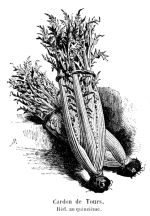 If you have ever seen a cardoon it was probably a garden specimen planted because of the architectural quality it provides. The recorded history of the cardoon goes back to ancient times when the fourth-century Greek writer Theophrastus first described it. The ancient Greeks, Persians,and Romans ate it and it continued to be cultivated in Europe for food during the Middle Ages to modern times. It was brought to the US by the early colonists but by the late 19th century lost its popularity in the US.
If you have ever seen a cardoon it was probably a garden specimen planted because of the architectural quality it provides. The recorded history of the cardoon goes back to ancient times when the fourth-century Greek writer Theophrastus first described it. The ancient Greeks, Persians,and Romans ate it and it continued to be cultivated in Europe for food during the Middle Ages to modern times. It was brought to the US by the early colonists but by the late 19th century lost its popularity in the US.
Cardoons are thistle-like herbaceous perennials native to the hot dry climate of the Mediterranean area. When they were introduced into California they became a nuisance and are considered weeds. Cardoons are members of the aster family, Asteraceae, and are in the same genus and species as globe artichokes.
The Cardoon de Tours is one of the best known varieties of cardoon because of the unique flavor of its stems, leaves, and root. Thomas Jefferson grew the Tours at Monticello and served it to guests at the White House. In addition to the unique flavor the Tours provides, it also has less tendency to become pithy during dry weather and is hardier than other cardoons. It has very thick and fleshy ribs but is also one of the thorniest cardoons, making it more difficult to handle.
The flowers and stem of the plant are eaten although the stem is the most popular. Both flowers and stems have an artichoke-like flavor and the stalk has the texture of celery. The stalks with fibers removed, can be prepared in several ways: raw, baked, steamed, sautéed, braised, and fried. They are especially tasty with cream sauce.
Plants are easily grown in the home vegetable garden. They need fertile, moderately moist, well-drained soil and full sun. The flowers appear about two months after planting, and the stalks are harvested in winter and spring.